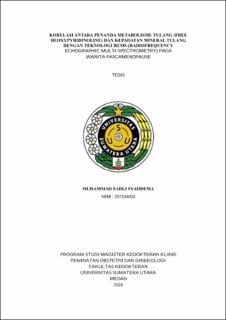Korelasi Antara Penanda Metabolisme Tulang (Free Deoxypyridinoline) dan Kepadatan Mineral Tulang Dengan Teknologi Rems (Radiofrequency Echographic Multi-Spectrometry) pada Wanita Pascamenopause
Correlation Between Bone Metabolism Markers (Free Deoxypyridinoline) and Bone Mineral Density Using Rems (Radiofrequency Echographic Multi-Spectrometry) Technology in Postmenopaused Women

Date
2024Author
Syahdema, Muhammad Fadli
Advisor(s)
Siregar, Muhammad Fidel Ganis
Ardiansyah, Edy
Munthe, Indra Gunasti
Effendi, Iman Helmi
Rachmatsyah, M. Yusuf
Metadata
Show full item recordAbstract
Background: The menopausal transition (MT) is a critical period of bone
strength change in women, setting the stage for the development of osteoporosis
and fracture susceptibility in older age. BMD begins to decline approximately 1
year before FMP, and continues to decline in early postmenopause, with a slight
decrease in the rate of loss approximately 2 years after FMP. Evaluation of free
deoxypyridinoline levels in osteoporosis patients is essential because increased
free deoxypyridinoline indicates demineralization that can reduce bone mass.
Bone densitometry assessment with radiofrequency echographic multi spectrometry (REMS) is a new ultrasound-based technique that can reliably
assess BMD at the lumbar spine, femoral neck, and hip. The use of REMS has
been validated in postmenopausal osteoporosis and has been approved as a
possible alternative to DXA
Methods: This study is an observational analytical study with cross-sectional data
collection. The subjects of the study were 32 postmenopausal women who
examined Bone Metabolism Markers (free deoxypyridinoline) using elisa which
were then examined for Bone Mineral Density with REMS (Radiofrequency
Echographic Multi-Spectrometry) Technology and compared.
Results: In predicting osteoporosis in postmenopausal women is 63.8% with a p
value = 0.299 and 95% IK 36.7% - 90.9%. This shows that DPD levels cannot be
used to predict osteoporosis in postmenopausal women. The composition of
deoxypyridinoline ranges from 21% of the total cross-linking in bones.
Approximately 40-50% of cross-linking is present during the formation of 30-40%
with a number of small peptides, cross-linked telopeptide (N-telopeptides and
Ctelopeptides) in addition to the TRAP enzyme and calcium, as a biochemical
marker substance for resorption or bone remodeling. The sensitivity value in the
study is related to the theory that the composition of deoxypyridinoline is only
around 21% during bone remodeling.
Conclusion: There was no significant correlation between DPD levels and bone
mineral density. This indicates that DPD levels cannot be used to predict
osteoporosis in postmenopausal women.
Collections
- Master Theses [320]
